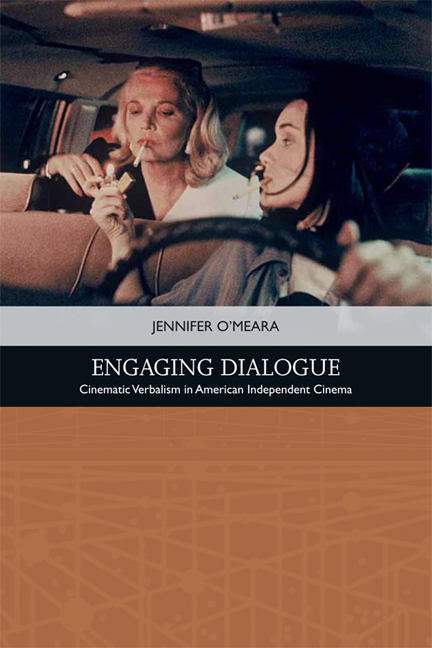Book contents
- Frontmatter
- Contents
- List of Figures
- Acknowledgements
- Introduction
- 1 Measuring Engaging Dialogue
- 2 Verbal-Visual Style and Words Visualised
- 3 The Integrated Soundtrack and Lyrical Speech
- 4 Dialogue and Character Construction
- 5 Embodying Dialogue: Rich Voices, Expressive Mouths and Gesticulation
- 6 Gendered Verbal Dynamics: Sensitive Men and Explicit Women
- 7 Adapting Dialogue and Authorial Double-voicing
- Conclusion: Verbal Extremes and Excess
- Filmography
- Bibliography
- Index
3 - The Integrated Soundtrack and Lyrical Speech
Published online by Cambridge University Press: 01 May 2021
- Frontmatter
- Contents
- List of Figures
- Acknowledgements
- Introduction
- 1 Measuring Engaging Dialogue
- 2 Verbal-Visual Style and Words Visualised
- 3 The Integrated Soundtrack and Lyrical Speech
- 4 Dialogue and Character Construction
- 5 Embodying Dialogue: Rich Voices, Expressive Mouths and Gesticulation
- 6 Gendered Verbal Dynamics: Sensitive Men and Explicit Women
- 7 Adapting Dialogue and Authorial Double-voicing
- Conclusion: Verbal Extremes and Excess
- Filmography
- Bibliography
- Index
Summary
Writing in what can be seen as one of the earliest attempts to rid film dialogue of the charge of redundancy, John Fawell (1989) focuses on the ‘musicality’ of the film script. He explains how Howard Hawks repeats lines so that each ‘comes to assume, like a musical refrain, a greater savor and significance’ (45). A similar kind of musicality can be identified in independent film dialogue, one that extends to include speech that draws attention to language's rhythmic and aesthetic qualities. This chapter considers the cinematic verbalists’ soundtracks as a whole, arguing that their careful approach to dialogue extends to include a creative strategy when combining dialogue, music and sound effects.
Despite the prominence of dialogue and the voice on the soundtrack or – to use Chion's terms – its ‘verbocentrism’ and ‘vococentrism’ (1994: 5–6), dialogue does not receive commensurate attention in sound theory literature – although it can in practical handbooks. Integrated approaches to the soundtrack are also rare but, as Paul Thebérge (2008: 66) notes in his study on the interplay of sound and silence, research that analyses each aspect separately is removed from how the sound designer conceives it, the mix engineer creates it and the audience hears it. Instead, the aesthetic and emotive significance of music is often highlighted over the other components. In dedicating a chapter of American Smart Cinema (2012: 107) to the ‘peculiar “ musicality”’ of films grouped under this heading, Perkins considers music that serves as ‘an excessive element that unbalances narrative flow by emphasising the plasticity of the image’ (17). Her discussion of ‘smart’ soundtracks helpfully examines the importance of music to such films, but it somewhat downplays the significance of dialogue to the sound mix, including its ability to similarly emphasise artificiality through excess. Thus, instead of focusing purely on the music, the discussion of soundtracks here is focused on the interaction of music and sound effects with the dialogue (and other vocal noises): this will include how musical choices made by characters are verbally contextualised, and how these indie filmmakers blur the boundaries between sound effects and dialogue. In particular, by incorporating portions of inaudible dialogue, they seem to position audience members as eavesdroppers rather than sanctioned listeners – calling on us to listen selectively, and engaging us in the process.
- Type
- Chapter
- Information
- Engaging DialogueCinematic Verbalism in American Independent Cinema, pp. 49 - 74Publisher: Edinburgh University PressPrint publication year: 2018



